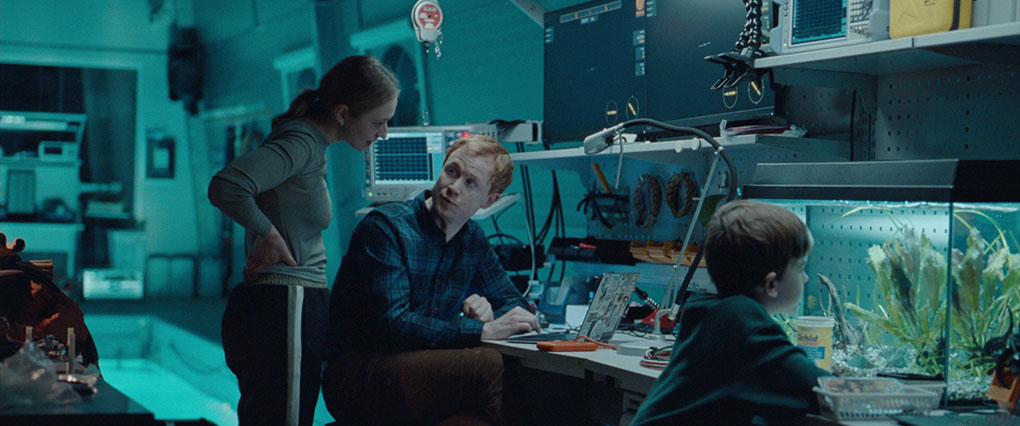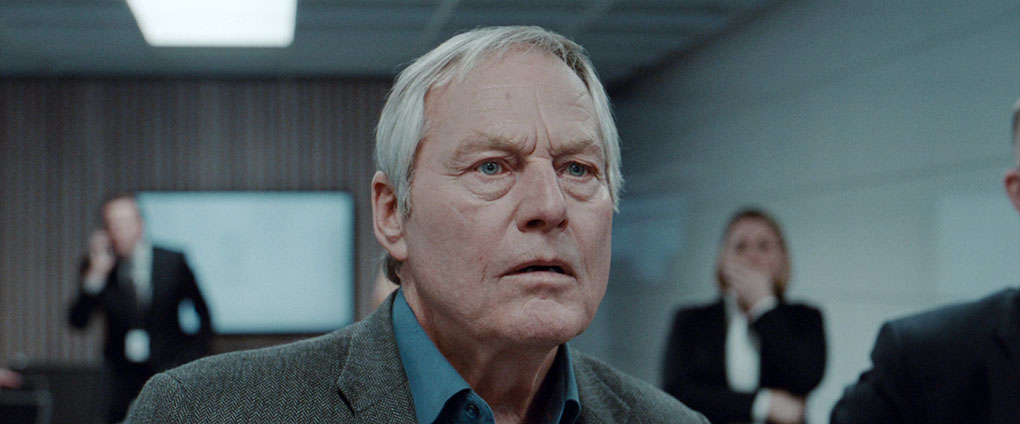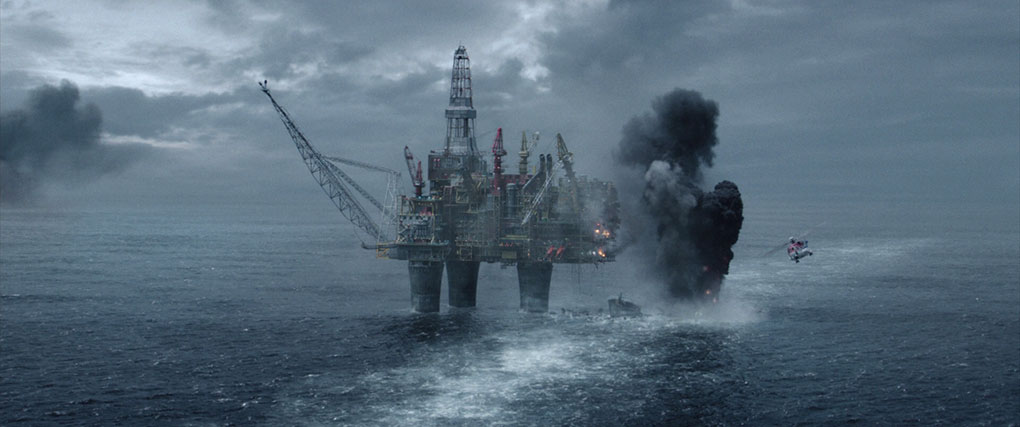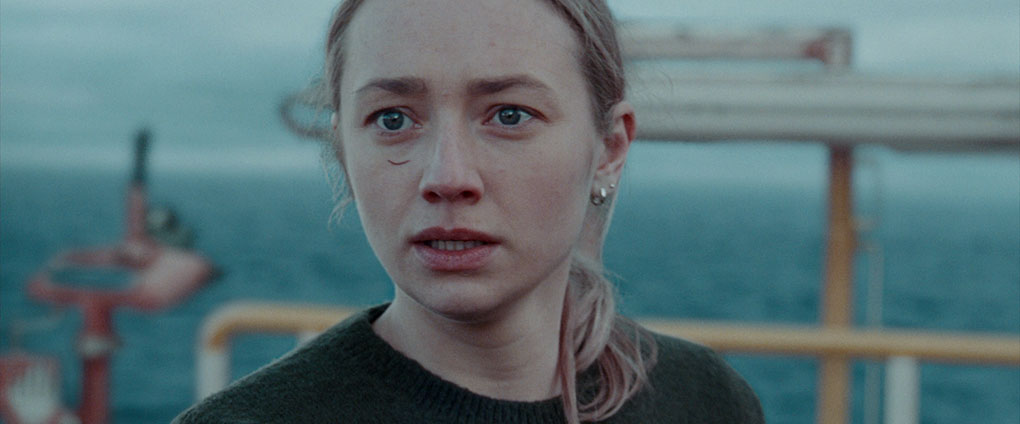|
If you've not been keeping your eye on international commercial cinema, you may not be aware that the Norwegian film industry is getting a bit of a rep for large scale disaster movies. First, we had The Wave [Bølgen] (2015), in which a landslide triggers a massive tsunami that roars down a deep and narrow fjord, unleashing widespread death and chaotic destruction. Written by John Kåre Raake and Harald Rosenløw-Eeg, it was directed by Roar Uthaug and stars Kristoffer Joner, Ane Dahl Torp, Jonas Hoff Oftebro and Edith Haagenrud-Sande as the at-peril family at its core. Its effects were spectacular, and the slow-burn build-up was quietly compelling – if anything, I found myself more captivated by this than the admittedly breathless second-half action and daring rescues. Here, the film feels like a more traditional disaster movie, peppered as it is with credibility-stretching plot twists and physical action. It's very well done, but doesn't match the slowly growing intrigue and worrying portents of the quieter first half.
Then came The Quake [Skjelvet] (2018), a four-years-later sequel that was again written by John Kåre Raake and Harald Rosenløw-Eeg and featured the same lead characters and actors, but this time was directed by John Andreas Andersen. Once again, I found the build-up more compelling than the action that unfolds once the earthquake of the title hits, a spectacular sequence that is over in a couple of frantic minutes. Realistic, yes, but if you came for the earthquake effects, you're likely to find yourself asking for a refund. Even the intriguing first half is saddled with a genre cliché in the family that has split apart and that you just know will be later reunited by the adversity to come. Well, sort of. As the earthquake looms, the behaviour of some of the characters is questionable enough to feel like the contrivance it is to separate them from each other and put them in death-defying peril when the quake hits. Once it does, credibility is once again strained by situations that rely too much on chance and some suspect physics.

And now we have the 2021 The Burning Sea (Nordsjøen, which somewhat less sensationally translates as North Sea), which was again directed by John Andreas Andersen, but this time written by Harald Rosenløw-Eeg in collaboration with Lars Gudmestad, and with a new cast of characters and no story connection to the previous two movies. Coincidence and genre cliché once again play their part, the CGI effects are as impressive as ever, and despite the scale of the eventual disaster, it's primarily about the threat posed to a single individual and his two would-be rescuers. Once again, it's built around a looming catastrophe that threatens massive destruction and thousands of lives, but by taking a different spin on a couple of genre tropes, it differentiates itself from its predecessors and becomes more of an action-thriller than what I'd normally classify as a disaster movie.
Our lead characters here are Sofia (Kristine Kujath Thorp) and her boyfriend Stian (Henrik Bjelland), a single parent whose young son Odin (Nils Elias Olsen) has already accepted Sofia as part of the family, even though she remains reluctant to move in, preferring instead to just spend the night when she visits. This is first rather neatly inferred when Sofia finishes brushing her teeth in the morning and after a quick pause for thought, pops her toothbrush into toiletry bag instead of the glass in which Stian and Odin's toothbrushes sit. She then makes the solo drive to her job as an offshore robotics operator, in which she is partnered by the affable and similarly aged Arthur (Rolf Kristian Larsen). They waste no time in delivering a bit of foreshadowing when Sofia takes Arthur up on a bet that she can't manoeuvre their snake-like robot through an underwater obstacle course in less than a minute, only to be tripped up at the last second by over-eager haste. Any suspicion that Sofia and Arthur are more than just colleagues and friends is quickly dispelled when they finish work and drive to a barbecue with Stian's oil worker friends, a social event at which Sofia and Stian are at ease but the more socially awkward Arthur is somewhat less comfortable, despite the warm welcome he receives from Stian.
A quick aside. I assumed that the robot that Sofia operates was a (possibly CG) creation of the filmmakers, but a little research revealed that this was not the case. Not only does the robot in question function almost exactly as shown in the film – indeed, the real one appears to be even more flexible and situation-adaptable – but the company that Sofia and Arthur work for, Eelume, is the name of both the real-world robot and the firm that developed it. A little bit of product placement, perhaps, but this machine is set to play an unsurprisingly crucial role in the story, and knowing it's the real deal lends a degree of authenticity to what subsequently unfolds.
The morning after the barbecue, Sofia and Arthur get an urgent call from oil drilling corporation SAGA – again, a real company – requesting their immediate assistance. They load up their equipment and are met at the airport by friendly-looking company emergency manager, William Lie (Bjørn Floberg). Before revealing what the call was about, he has them sign non-disclosure agreements, then unexpectedly turns his back on them and walks away. When Sofia calls out to ask him what the job is, he assures her he'll contact her when she and Arthur have been flown to the waiting transport ship. Clearly, something serious has occurred, something SAGA would prefer be kept quiet. Once on board the ship, Sofia and Arthur are indeed contacted by Lie, who reveals that one of the company's many North Sea oil platforms has collapsed, apparently due to local subsidence on the sea bed. The platform sank so quickly that there was no chance to evacuate the personnel on board, and Lie thus wants Sofia and Arthur to use the Eelume robot to search for survivors who might be holding out in trapped pockets of air. Their search uncovers a number of bodies – creepily floating underwater in their safety gear with their eyes wide open – and a lone survivor. He tries to communicate with them but soon begins to suffocate on what appears to be gas from an unknown source. Sofia realises too late what is occurring and rushes to warn the ship's captain to withdraw, then escapes with only a small cut to the face from flying glass when the gas that is bubbling to the surface explodes. The SAGA team analyse the speed with which the rig collapsed and realise that subsidence could not be to blame, and when studying the footage from the robot that evening, Arthur makes an alarming discovery, one that has the potential to put hundreds of North Sea oil rigs at risk, including Gullfaks A, the one on which Stian is crew supervisor.

Obviously, some of the key elements for a full-blown disaster movie in this setup. There's the scientific observation that proves to be a portent for large scale catastrophe, the big corporation with a vested interest in covering it up, the two field experts who lack the political clout to force preventative action, and the loved one who is unknowingly threatened by the potential consequences of corporate inaction. The path to formulaic disaster seems to be confirmed when Sofia takes the robot footage to Lie, who is calmly dismissive of what it seems to show, then asks if he can keep the hard drive on which the footage is stored. Sofia agrees, and Lie promptly stands up and departs, reminding Sofia as he does do of the confidentiality agreement that she signed. Easy to see how this is going to play out.
Except it doesn't, and as I'm going to get into potential spoiler territory here, those looking to go into the film with as little forewarning as possible may want to hop to the next paragraph to avoid having a couple of key (early) plot points revealed. Still with me? Okay, then. As a frustrated Sofia heads back to the lab, Lie calls an emergency meeting of top SAGA executives, to whom he shows Sofia's footage, also revealing that the rig went down due to subsidence caused by a potentially massive rift in the sea bed. He even provides some geological and historical background to its appearance, linking it to a massive, 8,000-year-old submarine landslide known as the Storegga Slide. It's also inferred that the massive drilling operation in the North Sea that has so boosted Norway's economy has turned the sea bed into the equivalent of Swiss cheese, syphoning the oil from now-vacant pockets that are potentially on the verge of collapse. And here's where the film diverges from the usual disaster movie template. Normally, I'd expect the executives to pooh-pooh Lie's warning and instead express their concern about the commercial impact of acting on his reckless advice. But when he reminds them that the oil spill from Deepwater Horizon (look it up if it's new to you – it was also the subject of a disaster movie) was the size of Denmark, and that SAGA has 350 such wells, each capable of creating similarly sized spills if the predicted disaster does hit, the board unexpectedly sanctions the immediate closure and evacuation of every rig. Colour me impressed. However… A control centre operative is unable to remotely close one of the wells on the Gullfaks A rig, so Lie contacts the platform chief, Ronny Helseth (Anders Baasmo), to request that he close it manually to prevent a spill. Seeing that Ronny is busy coordinating the evacuation, his trusted supervisor and good friend Stian volunteers to go down and fix the problem instead. Now you really can write some of what subsequently unfolds yourself.
In common with its predecessors, it's the build-up to the impending disaster that impresses the most in The Burning Sea, thanks in no small part to winningly low-key performances across the board, 22 July cinematographer Pål Ulvik Rokseth's documentary-like handheld camerawork, and John Andreas Andersen's assured and winningly low-key direction. When the action hots up, the pace is accelerated – aided by Johannes Ringen and Johan Söderqvist's score and Kalle Doniselli Gulbrandsen and Christian Siebenherz pulse-raising editing – but the style set by the earlier scenes is maintained, giving the film a strong sense of visual continuity. Also carried over from The Wave and The Quake is the decision to make the safety of the members a single family the primary focus, though this time around there is less in the way of human collateral damage. At one point the risk is reduced to a single individual (hop ahead again to the next paragraph to avoid possible spoilers), which only expands to include Sofia and Arthur when the decision is made to not risk a rescue operation for a man whom they suspect may already have perished. And all the while back at the control centre, Odin sits looking quietly lost and hopeful, there to remind us of the true cost of losing even a single life, lest we should somehow forget.

Although a little formulaic and predictable in its second-half winding up of tension and action, it's still slickly done, and the grounded performances and handling keep it on the safe side of disaster movie cliché. As expected, a cascade of perils are manufactured to threaten the lead players, with the escalating nature of the impending catastrophe timed to force quick thinking and desperate measures, which in turn trigger a whole new set of sometimes credibility-stretching problems to conquer. It also leads to a plot twist that I had originally intended to discuss in more detail after another spoiler warning, one that really pissed me off for reasons that I won't get into here but which I'll probably end up discussing in more detail in a blog that will be littered with spoilers for a whole slew of films, this one included.
I'm still in two minds about this new wave (no pun intended) of Norwegian disaster thrillers, though will happily take them any day over the preposterous excesses and silliness of The Day After Tomorrow, 2012, Volcano or San Andreas and the like. All three films shine in the economy of their character introductions, the pleasing restraint of their performances, and the convincing manner in which the warning signs are slowly established, interpreted, and acted upon. It may seem odd to suggest that the large scale, special effects destruction that is in theory the raison d'être of disaster movies is of less importance here, but for me is where these otherwise distinctive films take on a more formulaic feel, and where the credibility of the earlier scenes tends to flounder. Buy into it, though, and there's plenty to wind you up in The Burning Sea, even if the piling of calamity on calamity does occasionally see it pushing its luck. In common with its predecessors, it's a well-made and compellingly acted film, and by narrowing its focus to a small connected group, keeping the science and the threats largely plausible, incorporating real world locations and equipment, and taking a sly dig at our increasingly problematic reliance of fossil fuels, for me it's step up from the sometimes "oh come one" perils of The Quake. No masterpiece, perhaps, but an enjoyable, pacy and engaging take on the disaster thriller formula, and if you came for the piling on of perils, you'll absolutely get your money's worth in that breathless second half. Whether this short run of Norwegian disaster thrillers ends here or is set to continue is anybody's guess at the moment of writing. Given my uncertainty about some aspects, if another does come along, will I take the time to hunt it out and see it? Damned right I will.
Framed 2.40:1 and apparently shot on 35mm film rather than digital (I've yet to confirm this, but London processing labs are listed in the end credits), in common with just about any modern, action-driven feature, it looks immaculate on Blu-ray, with sharply defined detail, well-balanced contrast, solid black levels, and robust colour reproduction, at least within the restrictions of the alternately warm and cool-toned grading. Given that this was likely mastered from the digital edit, the fact that it is spotless should come as no surprise.
You can watch the film in its original Norwegian with English subtitles in DTS-HD Master Audio 5.1 surround or Linear PCM 2.0 stereo, in Norwegian without English subtitles in DTS-HD Master Audio 5.1 surround or Linear PCM 2.0 stereo, and with an English language dub in DTS-HD Master Audio 5.1 surround. I've listed all of these separately because, a little unusually, the preferred language option must be chosen in the Setup menu on the disc title screen before you watch the film. You cannot change language options on the fly, and if you return to the main menu to change the soundtrack midway through – as I tend to do to compare the tracks – you have to restart the film from scratch.

So what of the quality? It can come as no surprise that a recent disaster thriller like The Burning Sea sounds best in DTS-HD surround. The dynamic range is excellent, with crystal clear dialogue, effects and music, and a genuine wallop to the LFE bass – my system's subwoofer got a serious work-out here. It also makes solid use of the surrounds, but primarily for location effects, music and ambient sound. The stereo track is also very clear, but doesn't have quite the same degree of finesse, and lacks the impressive bass and surround sound of the DTS track. As for the English dub, well, I've heard worse, but the subtlety of the original performances is lost here, and a couple of the supporting characters are not at all well served by their English language replacement. Go with the original.
Not a bloody thing. It was the same story with the Studiocanal Blu-ray of The Wave, and it feels like a massively missed opportunity, not just to differentiate the Blu-ray from the version available to stream, but also because I'd love to have seen some background detail on the Eelume robot technology.
A solid disaster thriller that starts compellingly, then takes a more formulaic turn when the action hots up. If this doesn't worry you, then you should have a ball, and if you're already a fan of The Wave and The Quake, this is a must-see. Whether the Blu-ray is worth buying over a digital version will be a personal call. The image quality of the disc will always have the edge, but the lack of special features seriously disappoints. If, like me, you're a fan of physical media, then this is still the version to go for.
|